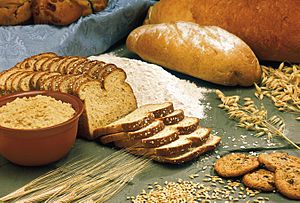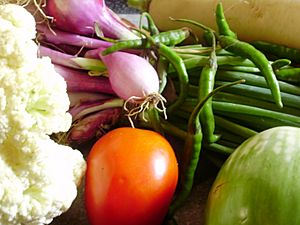Food group facts for kids
A food group is a way to sort different foods that are similar in their nutrition or how they are classified. Experts create nutrition guides to help people understand these groups. These guides also suggest how many daily servings from each group you should eat for a healthy diet.
Common Food Groups for a Healthy Diet
This section looks at the main food groups you'll often see in nutrition guides. These groups help you choose a balanced diet.
Dairy Products: Milk and More
- Dairy includes foods made from milk, like milk itself, butter, yogurt, and cheese.
- Sometimes, milk alternatives (like almond milk) are grouped here too.
- Dairy is usually a smaller group in most nutrition guides.
- Some health groups, like the Harvard School of Public Health, suggest that adults don't need a lot of dairy. They say that one to two servings a day is good for children, but not always essential for adults.
Fruits: Nature's Sweet Treats
- Fruits are often grouped with vegetables.
- Common fruits include apples, oranges, bananas, berries, and lemons.
- Fruits provide carbohydrates, which are a type of energy for your body.
Grains: Energy for Your Day
- Grains, also called cereals, are often the largest group in nutrition guides.
- This group includes foods like wheat, rice, oats, barley, bread, and pasta.
- Sometimes, starchy foods like potatoes are also included with grains.
Meat and Protein: Building Blocks for Your Body
- Meat is often called the protein group.
- This group can include legumes (like beans and lentils), eggs, and meat substitutes.
- Examples of meat are chicken, fish, turkey, pork, and beef.
- This group is usually a medium to smaller size in most nutrition guides.
Sweets: Enjoy in Small Amounts
- Sweets are also known as sugary foods.
- This group sometimes includes fats and oils.
- Sweets are usually a very small group in nutrition guides.
- Sometimes, this group isn't even included or is kept separate from other food groups.
- Examples are candy, soft drinks, cake, pie, and ice cream.
Vegetables: Colorful and Nutritious
- Vegetables are often grouped with fruit.
- This is usually a large group in nutrition guides.
- Only grains are typically a larger group than vegetables.
- Some common vegetables are spinach, carrots, onions, peppers, and broccoli.
Water: Essential for Life
- Water is treated differently in various nutrition guides.
- Some guides don't include water, while others make it the most important part.
- Water is sometimes grouped with tea, fruit juice, vegetable juice, and even soup.
- It is always recommended to drink plenty of water.
Less Common Food Groups
The number of "common" food groups can change depending on the nutrition guide. For example, Canada's Food Guide, which has been around since 1942, officially recognizes only four main food groups. Other foods are often called "another" category.
Alcohol: A Special Category
- Alcohol is usually kept separate from other food groups in nutrition guides.
- Some guides, like Harvard's Healthy Eating Pyramid, suggest that alcohol should only be consumed in very small amounts by certain people.
- Other guides, like Italy's food pyramid, might include a small serving of wine or beer.
- It's important to remember that alcohol is not a necessary part of a healthy diet for young people.

All content from Kiddle encyclopedia articles (including the article images and facts) can be freely used under Attribution-ShareAlike license, unless stated otherwise. Cite this article:
Food group Facts for Kids. Kiddle Encyclopedia.


